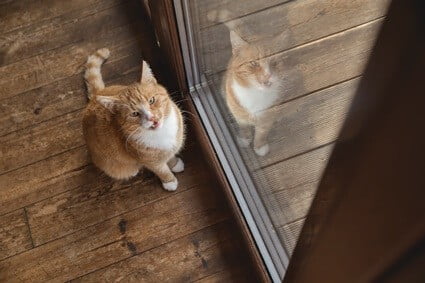As an owner, you’ll need to decide if you are happy to let your cat wander outside. If you choose to let your cat out, ensure you have taken all necessary precautions to keep your cat safe.
Cats should be introduced to the outdoors gradually. Consider walking your cat on a leash until it builds enough confidence. This will help your cat take the surroundings and risks of the outside world. Keep increasing this accompanied time outside until your cat is ready to go outdoors alone.
If you decide to let your cat outside, you will need to be consistent. You cannot let your cat go out one day, then keep it in the next. Cats grow accustomed to a routine and will expect to enjoy the same freedom.
Should Cats Be Kept Indoors?
Keeping cats indoors or letting them outside is a debate that has long raged among owners. As per Applied Animal Behavior Science, some indoor cats develop behavioral issues. Cats are curious by nature and driven by instincts that would lead them outside.
These problems can be managed by creating an enriching environment for your cat. Time outdoors is not a necessity for any cat. What matters most is that you understand the needs of your feline friend.
If you are going to let an indoor cat outside, you need to prepare accordingly. It is not as simple as opening the door and letting the cat wander off. This could potentially have dire repercussions.
My Indoor Cat Suddenly Wants to Go Outside
It is common for all cats to show an interest in going outside at some stage. Even if a cat has always lived indoors, it may start to paw at windows and doors to ask to be let out. There are four common explanations for this behavior:
Curiosity
Likely, your cat is curious about the outside world. This will become increasingly prevalent if you leave the cat alone during a working day.
Your absence will be noted, and the cat will wonder where you have gone. As per PLoS One, cats seek longer periods of interaction from owners after being separated. This busts the myth that cats are cold and uncaring toward their owners.
What’s more, you will carry a range of scents with you whenever you return from time outside. Cats have sensitive noses. Your cat will be desperate to know where you are spending your time, and what they are missing out on.
Seeking Territory
Cats are hardwired to seek out territory. This is why it is so important to assign feline-specific terrain within the home. If your cat does not have its own territory, it will claim it through scratching your carpets and furniture.
For some cats, territory within the home is not enough. Some felines, especially males, will always be looking for more territory. This leads to a far-reaching wanderlust. Neutering a male will drastically reduce this instinct.
Being forced to share territory and resources will also drive some cats outside. Feline groups fall into a natural dominant and submissive dynamic. While most cats accept their place, bullying or refusal to share can create a desire to seek privacy.
Hunting Instinct
Cats, whether wild or domesticated, are born hunters. As explained by the European Journal of Wildlife Research, outdoor cats can significantly impact the ecosystem of any territory. This desire to stalk smaller prey will occasionally become overwhelming.
If you notice your cat chirping at birds from a window, hunting instincts are starting to kick in. The cat has previously been content to watch. Now, it is showing an increasing desire to get outside and hunt down its quarry.
This instinct can be curbed by regularly playing with your cat. String toys or laser pointers can satisfy the hunting drive of a feline. Giving the cat something tangible to stalk and catch will have the best results.
Entering Heat
If your cat is an unspayed female, she will enter heat at some stage. Usually, a queen will enter her first estrus cycle before she reaches 6 months. At this point, your cat will undergo behavioral changes. Signs of a cat in heat include:
- Verbalizing to excess, especially at night
- Attempting to get outside at any opportunity
- Growing more affectionate toward owners
- Losing appetite
Cats in heat have only one thing on their mind – getting outside and mating. If you do not wish to spay your cat, prepare yourself for a noisy couple of weeks. The cat will yowl and howl to be let outside near-constantly. Do what you can to make her feel more comfortable.
Male cats that have not been neutered do not enter heat. They do scent nearby females that are primed for breeding, though. This will result in similar behaviors to a female in heat. Your male will be desperate to acquiesce to the wishes of the nearest female.

Should You Let an Indoor Cat Go Outside?
It is a matter of personal choice as to whether you let an indoor cat go outside. Cats are capable of living full, happy lives exclusively indoors. All the same, is it OK to let an indoor cat outside?
As per the Compendium on Continuing Education for the Practicing Veterinarian, the American Veterinary Medical Association recommends keeping cats inside. Many domesticated cats all over the world wander free, though.
Learn what to do when an indoor cat wants to go outside. This will help you keep your pet safe. We recommend taking the following steps to transition your indoor cat to the outdoors:
- Get a cat leash and get your cat used to be walked around the house. Your cat will likely initially resist this as being restrained is anathema to most felines.
- Once your cat accepts the leash, walk it outside. Let the cat grow used to the sounds, scents, and sights of the outdoors, so it builds confidence.
- Let go of the leash so the cat can wander, but stay close enough to pick it up again if any danger presents itself.
- Head outside with your cat several times. Introduce the cat to as many important elements of the outside world as you can, including traffic and adverse weather.
- Take your cat to the vet to be microchipped. This is not mandatory but will help you be reunited with your cat should it get lost.
- Ensure your cat is completely protected against fleas, ticks, and other parasites.
- Consider fitting a belled collar on your cat for the sake of the local bird population. Wildlife Research confirms that belled collars halve avian deaths.
- Create a schedule for when you let your cat outside. Do not let it simply come and go as it pleases.
The latter is arguably the most important step. Unless you have a cat flap, your cat may wake up at all hours demanding to be let out or back in. If you do have a flap, train your cat to use it. Remember, other animals can also access your home through a cat flap.
What Happens When an Indoor Cat Goes Outside?
This depends on the cat in question. Most cats that venture outside will engage in the following activities:
- Hunting wild prey, such as rodents or birds
- Seeking new territory and claiming it as the cat’s own
- Locating emergency food and water sources
- Visiting other homes for additional feeding or attention
Unless you install a tracker, there is no way of knowing what your cat is getting up to. You’ll need to trust your cat if you let it outside and be prepared to react to any outcome.
How Long Should You Keep a Cat in Before Letting it Out?
Do not let your cat outside as soon as you bring it home. If you have a kitten, it must be fully vaccinated before it ventures outside. It is advisable to wait at least 2 weeks after the final round of injections. Kittens are vulnerable to infectious respiratory diseases.
Even if you adopt an adult cat, wait at least a month before letting it outside. You need to forge a bond with the cat first and ensure it feels comfortable in your home. If your cat does not have a reason to return, it will not do so.
The same timeframe applies to letting cats out for the first time after moving. Cats are creatures of habit. If you let your cat out too soon, it will immediately try to return to your previous home. Allow the cat to accept its new habitat before exploring outdoors.
I’m Scared to Let My Cat Outside
You may be nervous about letting a cat outside, especially for the first time. If you are not comfortable with the idea, keep your cat indoors. If you meet all its needs, the cat will not suffer for this.
If you decide to let your cat outside, mask your fear and apprehension. Cats pick up on human emotion. If the cat senses that you are afraid, it will assume there is something to fear beyond the front door.
Cats are often nervous by default, and this will magnify any natural anxiety. What’s more, the cat will be on constant alert, convinced that danger lies around every corner. This may lead to erratic, risk-taking, or aggressive behavior.
How Long Will an Indoor Cat Stay Outside?
This depends on the cat and how much it enjoys time outside. Many cats worship the sun and will gleefully bask for hours on a summer’s day. Keep an eye on this, as excess sunshine can be harmful to cats.
If your cat has not been spayed or neutered, it may also stay out for longer. This is because such cats will constantly be on the lookout for new territory or a potential mate.
The more comfortable your home is, the likelier the cat is to return quickly. Establish a routine for your cat, and it will likely come home in short order, especially for scheduled mealtimes or in adverse weather.
Can an Indoor Cat Survive Outside?
As we will discuss shortly, there are risks to letting indoor cats outside. It will be a judgment call as to whether you are prepared to take this chance.
Cats are hardy and governed by survival instincts. Most indoor felines can adapt to the harsh conditions of the outside. Stray cats are less equipped for life on the streets than their feral counterparts, though.
Overall, we would say that indoor cats can survive indoors. Surviving is not the same as thriving, though. Indoor cats grow accustomed to a degree of comfort and are not as streetwise as other animals. This can lead to danger.
Risks of Letting Indoor Cats Outside
As above, there are certain hazards in the outside world that cat owners need to be aware of. Consider how you can manage any of the following risks before letting your indoor cat outside.
Getting Lost
The streets of any town in America are littered with lost cat posters. The journal Animals suggests that up to 15% of households lose their pets at some stage. Thankfully, around 75% of misplaced cats are reunited with their families.
Minimize the risk of a cat getting lost by walking it around the neighborhood on a leash. This gives the cat the chance to memorize its surroundings. If a cat can recall sights and scents, it is likelier to find its way home.
In case the worst happens, ensure your cat is microchipped, too. If a stray cat is presented to any veterinary surgery, this chip can be read. This will enable a vet to contact you and arrange for your cat to be collected.
Conflict with Other Animals
We have mentioned how cats frequently go in search of new territory when outside. Unfortunately, the territory has likely already been claimed. An aggressive neighborhood feline may not take kindly to your cat infiltrating its terrain.
Cats rarely fight unless they must, preferring to take an approach of ballast and bluster. If neither cat backs down in the face of hissing, a fight can break out. This will rarely be pleasant for either animal. Cats do not hold back when engaged in combat.
This could see your cat wounded. Scratches and bites can lead to bacterial infection. If your cat returns home in physical distress, patch them up and consider whether a veterinary check-up is required.
Road Traffic Accidents
Perhaps the greatest risk to indoor cats that are new to the outside is road traffic. Veterinary Record surveyed 117 road traffic accidents involving cats over 12 months. It was found that older cats were less likely to be struck by cars.
This suggests that these cats had developed street smarts. The more time they spend around roads, the most careful they became. A cat that has never seen traffic before may not understand the danger. Introduce your cat to roads while on a leash.
A different study from the same journal unearthed another interesting fact. Cats are likelier to be struck by cars in rural areas than cities. This is presumably because lower levels of traffic on the road allows vehicles to move at greater speed. Quieter roads may also inspire a false sense of security in a cat.

Parasites and Disease
Remember that the outside world has various parasites and diseases. Your cat must be vaccinated against common illnesses. It may still fall foul to contagious bacterial or fungal infections, such as ringworm.
Protect your cat against fleas and ticks, too. There is no way of knowing if other animals have been treated. A spot-in treatment is best. Flea collars can be dangerous, as some cats get these trapped on obstacles.
Will My Cat Come Back if I Let it Outside?
A common concern for owners is that cats will enjoy their time outside a little too much. Learn how to train a cat to go outside and come back. Ways to achieve this include:
- Establish a routine of when the cat should be outside and when it should come home. Build this around your cat’s circadian rhythms.
- Speak to your cat so it can recognize your voice. Your cat uses this as a homing beacon.
- Feed your cat at the same time each evening. The cat will return home at this time for its meal.
- Give your cat a treat whenever it returns. The cat will associate coming home with positive rewards.
Overall, if you have a strong bond with your cat, it will return. Cats love their owners and live with them by choice. Ensure this remains the case by meeting your cat’s needs and making your home a welcoming environment.
Why Is My Cat Scared To Go Outside?
There are many reasons why indoor cats may be frightened to go outside. As discussed, the cat may be picking up on human anxiety. Alternatively, the cat may be spooked by any of the following:
- Unfamiliar scents or sounds
- Worry about being lost without food
- Other animals, such as a barking dog in the neighborhood
- Reluctance to be among unfamiliar humans
- Previous trauma, such as being attacked by another cat
If your cat is reluctant to go outside, never force it to do so. As mentioned, indoor cats can live full and happy lives. There is nothing to gain by making a cat leave home when it has no desire to do so.
If you plan to let an indoor cat outside for the first time, prepare your pet in advance. Ensure your cat is comfortable and confident with the stimulus found outside and streetwise enough to understand road safety. These steps, coupled with a reliable routine, will help your cat adjust.

